Mobile app attribution allows acquisition marketers to understand how users learn about and start using apps. This allows marketers to map out data points for specific actions users take, from clicking an advertisement to installing the app to making in-app purchases.
In this article, we look at what mobile app attribution is. Then we discuss the features you need to look for in a mobile app attribution analytics platform.
Additionally, we compare AppsFlyer and Branch, two of the most popular mobile app attribution platforms. Hopefully, this comparison will help you determine the right solution for your business.
RELATED ARTICLE: THE 10 ESSENTIAL FEATURES YOU NEED IN YOUR CRM SOFTWARE
What Is Mobile App Attribution?
Mobile app attribution is the process of identifying how and where users learn about your app. Then it allows you to map interactions across platforms. Ultimately, this lets you monitor and optimize the journeys people take to becoming your customers.
Advertising platforms can provide a good deal of data on the effects your ads have on your conversion rate. However, these platforms are more interested in reporting conversions than in conveying information that could be more useful to you.
What’s more, if you’re working in a high-growth environment, then you’re likely running campaigns on several networks at once. Therefore, there’s high value in having the ability to consolidate reporting in a single place.
Ideally, mobile app attribution allows app marketers to collect unbiased data about their return on investment (ROI) from their various marketing efforts. This data gives insight into what led a user to install your app. Also, it allows you to figure out exactly what caused a rise or fall in app installs. This information is helpful in optimizing marketing campaigns. Additionally, you can use it when you’re scaling up a business. Also, you can use it to maximize your ROI.
To this end, here are some features you should look for in a mobile app attribution platform:
Mobile App Attribution Across Channels
Mobile app attribution across channels typically involves advanced technologies such as universal deep linking, fingerprinting, and secure postbacks for data sync.
Marketing Engagement Analytics
This involves combining mobile business and app use insights with mobile app attribution. This helps marketers to better understand and optimize sources of real value. For example, app marketers look at metrics such as user engagement, revenue, lifetime value, and ROI.
Integrations
It’s important to know which media sources, retargeting networks, third-party analytics platforms, and marketing automation providers your mobile app attribution platform offers integration with.
Data Integrity
Your mobile app attribution platform needs to collect its own data. Further, what you don’t want is a mobile app attribution platform that simply aggregates data that ad networks provide. Therefore, you need to select a platform that’s GDPR-compliant and follows industry security standards.
A Comparison of AppsFlyer and Branch
Now that we have a clear understanding of what mobile app attribution is, let’s compare two mobile app attribution providers, AppsFlyer and Branch. These are two of the leading providers in the industry. We’ll take a look at the key features of each. This will let you see how they stack up against each other in terms of features and functionality.
Factor #1: Mobile App Attribution Across Channels
We’re living in a multi-device, multi-channel world. Therefore, app marketers need to promote their products pretty much everywhere a potential customer might be active.
This can make it hard to know which specific marketing activities are driving conversions. That’s because the audience’s journey often spans a variety of “walled garden” digital environments. Therefore, since the customer’s journey is directed within those environments, it is difficult to monitor.
On the other hand, cross-channel mobile app attribution helps marketers understand which parts of their marketing strategies are most effective and which ones need to be scrapped. Without it, marketers would have no way of knowing what drives prospective users to act on a conversion goal.
AppsFlyer and Cross-Channel Mobile App Attribution
With AppsFlyer, you’ll be able to monitor every app install and connect it to the promotional campaigns and media sources that drove it. This makes it easy to see which media sources perform best. That’s because AppsFlyer’s granular dashboards let you know which channel or network, ad group, ad type, and ad creative drove individual users.
Additionally, the platform’s deep-linking feature enables you to direct users to the right app store. Then you can display a welcome message after the app is installed. This improves your customer’s user experience and increases conversion rates.
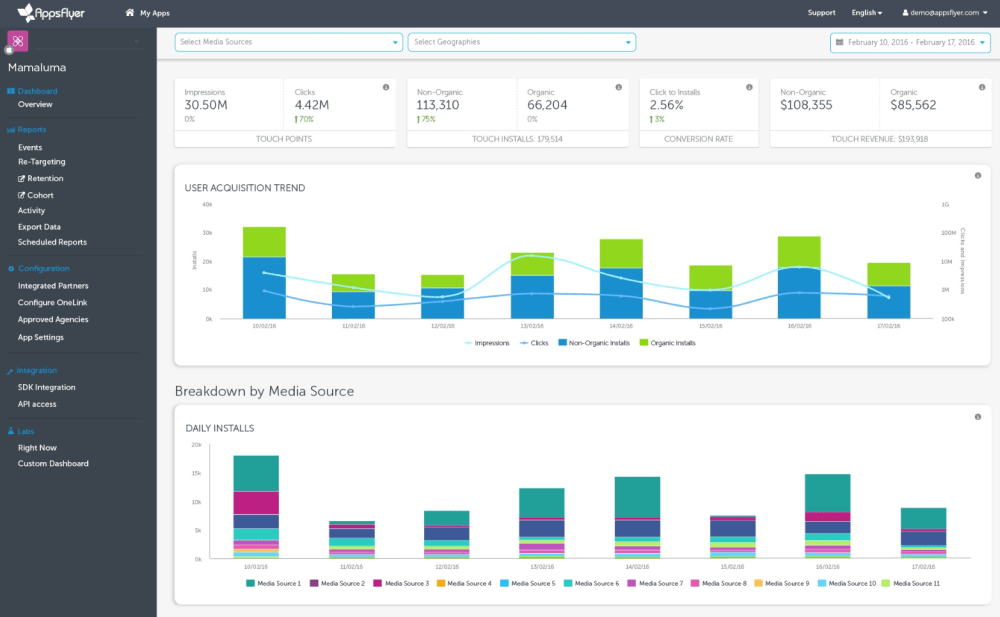
Most users interact with multiple ads before they decide to install an app. AppsFlyer’s multi-touch attribution enables you to know exactly which ads helped nudge the user in the right direction. Moreover, you’ll also know which ad was the driving factor behind the final install.
In addition, AppsFlyer helps you attribute new users coming from TV campaigns. This lets you promote your app via its deep integrations with TVSquared, Adalyser, and others. Also, it lets you generate reports about which marketing campaigns drive the best user re-engagement and reactivation results.
Branch and Cross-Channel Mobile App Attribution
With Branch, you can use automatic cross-platform identifiers to track your users on the web and in apps. Importantly, you can do this even if they’re logged out. Therefore, even if customers first learn about your app on a blog and then interact with your ad on Facebook, you’ll be able to connect touch points from each channel. Also, it lets you customize attribution windows based on your marketing campaigns, right down to individual links.
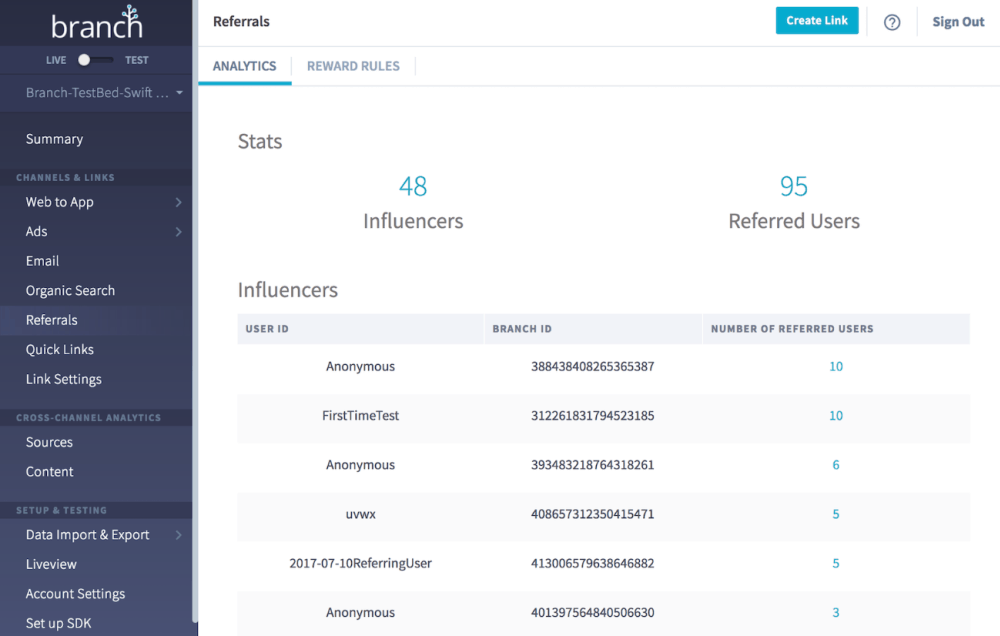
Additionally, Branch’s view-through attribution will give you insight into the users who viewed your ads, even when they didn’t interact with them (for example, by clicking the ad). This gives you a better idea about the ROI of your marketing efforts. That’s because views can help a great deal with brand awareness, even though CPM (cost per thousand) campaigns are measured differently across different networks.
Also, Branch aims for accurate attribution across all channels. It does this by using links to seamlessly track user engagement. Therefore, prospective customers will be able to view your ads and make purchases across multiple platforms.
Factor #2: Marketing Engagement Analytics
One of the key benefits of marketing engagement analytics is that they empower marketers to make informed decisions. Essentially, these analytics answer two important questions: Which marketing campaigns should you be investing in, and how should you prioritize them?
How AppsFlyer Performs with Analytics
With AppsFlyer, you’ll get useful insights about your marketing performance and user retention. That’s because its powerful cohort and retention reporting tools show you areas where marketing campaigns are doing great and where there’s glaring need for improvement.
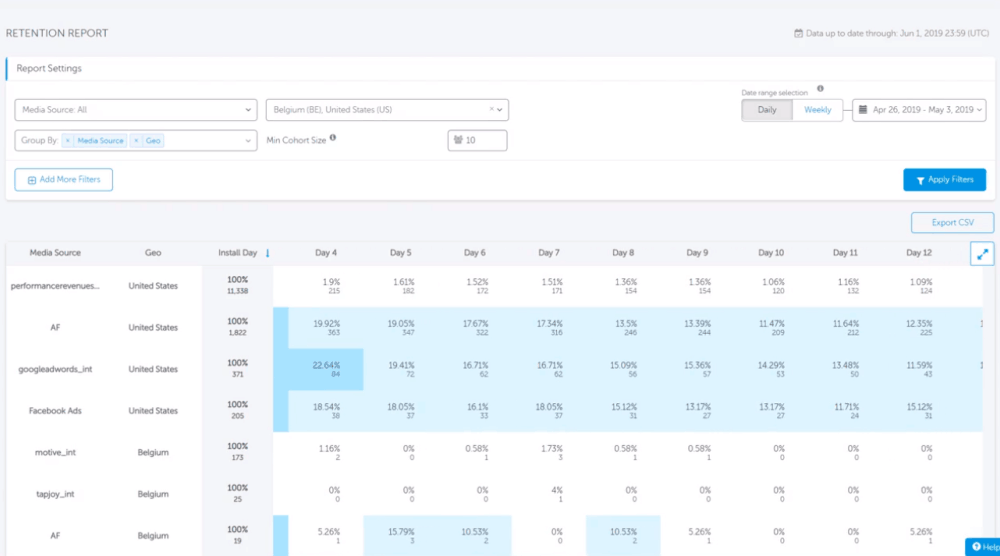
Additionally, you can customize AppsFlyer’s dashboard with their drag-and-drop interface. This way, you can easily build and view dashboards based on your specific campaigns.
Additionally, the AppsFlyer mobile app enables you to monitor analytics data in real time and share it with your team members. You can also receive live alerts about your key performance indicators (KPIs). Plus, you’ll get other information that’s important for your business.
What’s more, AppsFlyer’s Pivot tool also uses the drag-and-drop interface. This lets you quickly save, edit, clone, and collaborate with your team. Plus, you can do all of this without having to download data or rebuild pivot tables. This way, marketers can better manage and understand complex data. For instance, you can use it for aggregating performance by media source. Or you can run deep campaign analyses.
How Branch Provides Analytics
One of the practical-use cases of Branch’s detailed analytics reporting is that it makes it easy to identify top-performing influencer campaigns. For example, when you know which ones are driving the most app downloads, you can deepen your most lucrative relationships. Then you can also forge more of them with similar figures.
Although Branch does offer a cohort analysis tool to help marketers understand the ROI of their campaigns, it doesn’t support retention monitoring or reporting.
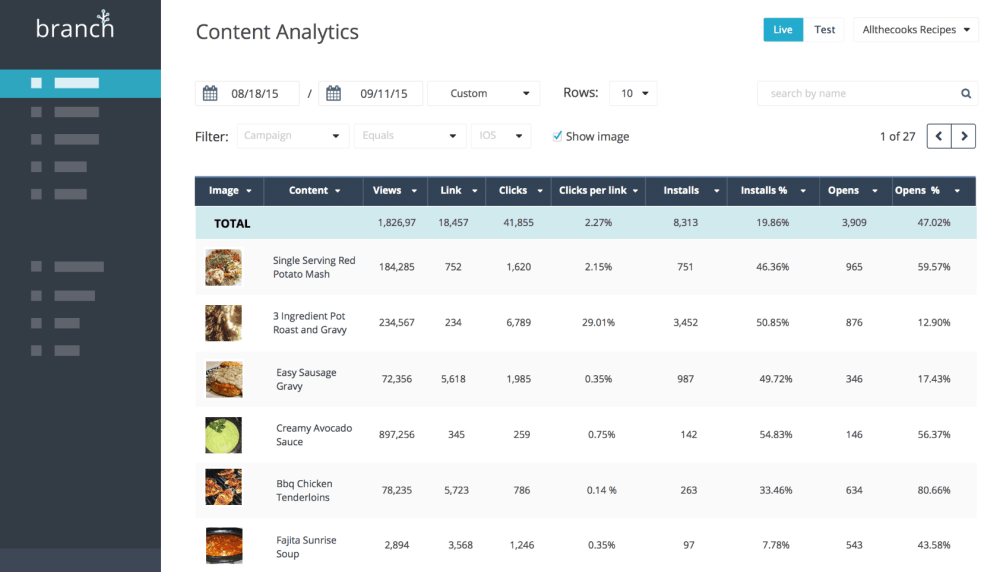
Branch’s Content Analytics section allows you to figure out which content is most successful at driving app installs. This way, you’ll be able to promote that particular content with marketing campaigns or deep linked sharing. With Branch, you can repeat this process to identify new content that drives app downloads.
Additionally, Branch’s Data Feeds feature allows you to import analytics data using several integrations. For instance:
- Webhooks let you send Branch events to any endpoint you want
- Data integrations offers a number of analytics and marketing features
- The query API will help you programmatically query analytics data
- Data export API will give you access to all of your Branch data
However, unlike AppsFlyer, Branch doesn’t let you create custom dashboards to view specific information sets based on your marketing campaigns.
Factor #3: Integrated Partners
The mobile ecosystem calls for many types of reports that have an effect on acquisition. These could include metrics from the services you use for attribution. Also, they can include product analytics, A/B testing, and marketing automation.
Integrating with third-party platforms provides more value to advertisers. That’s because you can use the insights you glean for optimizing marketing efforts or running retargeting campaigns.
Using AppsFlyer Mobile App Attribution with Integrated Partners
With the AppsFlyer software development kit (SDK) you can experiment with different integrated partners. This lets you identify the ones that give you the best ROI from your marketing campaigns.
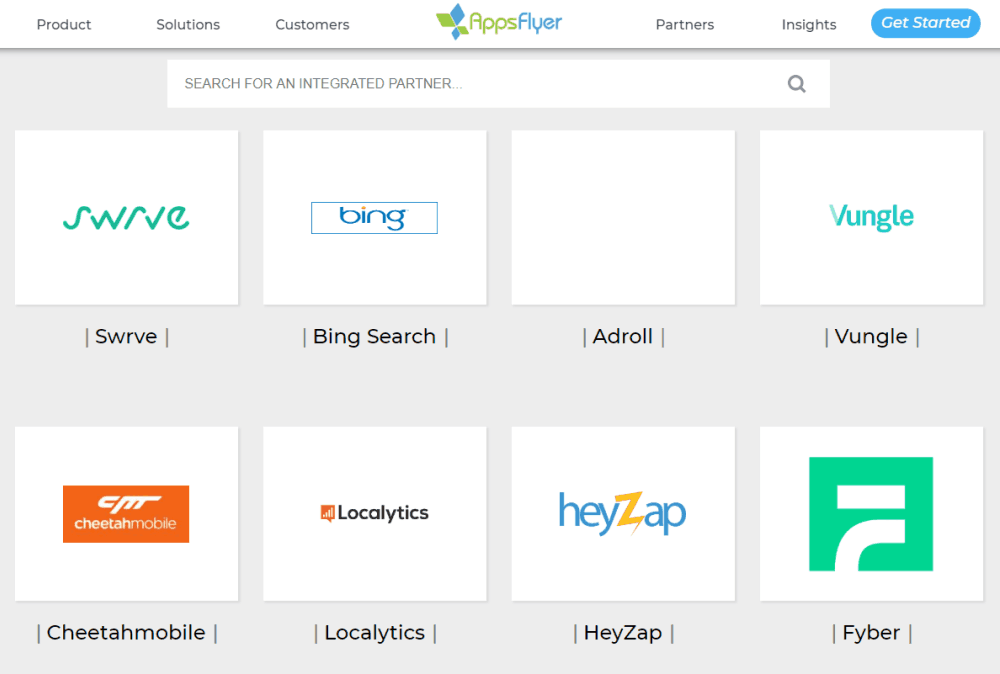
Here are some of the different types of integrated partners you can get access to with the AppsFlyer platform:
Ad Networks
These networks connect advertisers to apps looking to host ads. Ad networks act as consolidations of a large ad space supply from publishers and match it to fulfill advertisers’ demands.
Agency Reports
There are companies that manage marketing campaigns on behalf of advertisers. They might work with all types of apps or focus on a specific area, such as gaming apps.
Analytics Platforms
These are third-party solutions that offer in-app analytics reporting. Interestingly, these integrations can push data back and forth. Therefore, you can perform behavioral analysis based on various segments of your end users.
Affiliate Networks
These networks enable publishers to get a share of the revenue advertisers earn that result from visitors to the publisher’s app. Alternatively, publishers earn a fee for each visitor who performs a specific action.
RELATED ARTICLE: CRITICAL ASPECTS OF BUILDING AN AUTHORITATIVE AFFILIATE SITE
Retargeting Networks
These are ad networks that specialize in retargeting. Retargeting engages users who interacted with an ad but didn’t yet install the app. You can also use these networks for re-engagement. With re-engagement, you give targeted discounts to users who’ve already installed your apps to make them active users. Also, use these networks for re-attribution. These are campaigns targeted at users who’ve uninstalled the app to get them to reinstall it.
Direct Publishers
These are app owners who integrate their apps directly with AppsFlyer for superior in-app monitoring.
Facebook Marketing Partners/Twitter Official Partners
These are partners who comply with Facebook and Twitter’s criteria and get their approval. For example, this could be a particular technology such as automated posting apps. Or they could be media-buying platforms that allow marketers to book ads on Facebook and Twitter.
Programmatic Advertising
This refers to the ability of an ad network to buy spots for ads from different platforms without involving a third party.
Branch and Integrations
With Branch, you get a number of integrations to make sure your attribution workflow runs smoothly.
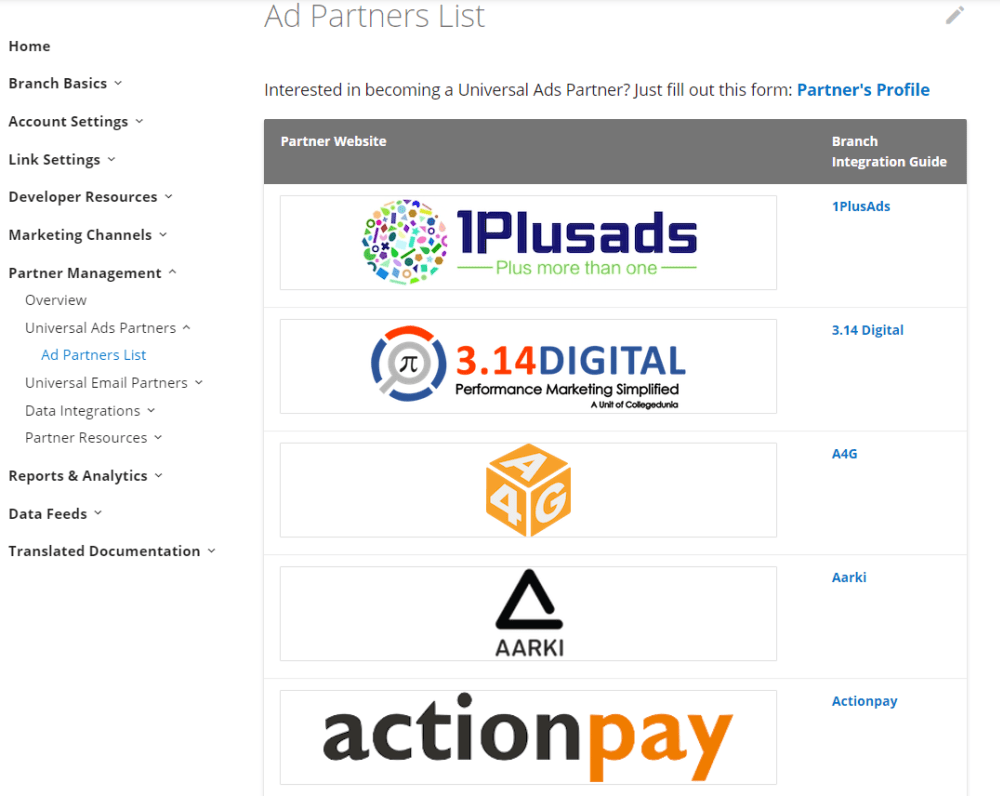
These include:
Universal Ad Partners
With Branch Universal Ads, you’re able to try out ad networks with unique segmentation algorithms to reach a targeted audience. This is available as a pre-configured and ready-to-use integration.
Universal Email Partners
These services enable you to seamlessly integrate email marketing campaigns within your workflows. For example, you can use leading email service providers without losing your current analytics.
Data Integration Partners
This integration enables you to use pre-formatted webhooks to automatically send Branch data to your analytics and marketing tools.
Factor #4: Data Integrity
When it comes to mobile app attribution, it’s important to make sure you’re keeping customer data secure. Failure to do so can cause serious data breaches. These can cause serious damage to your brand and might even expose you to potential lawsuits or fines from regulators.
AppsFlyer and Data Integrity
AppsFlyer maintains full compliance with industry standards. This means AppsFlyer keeps its data centers secure. Moreover, it enforces strict physical, environmental, and hosting controls.
Additionally, AppsFlyer uses multi-layered controls to protect the data infrastructure. This means it actively monitors the improvement of applications, systems, and processes regularly.
This continuous monitoring lets AppsFlyer keep up with the ever-changing security ecosystem and its challenges.
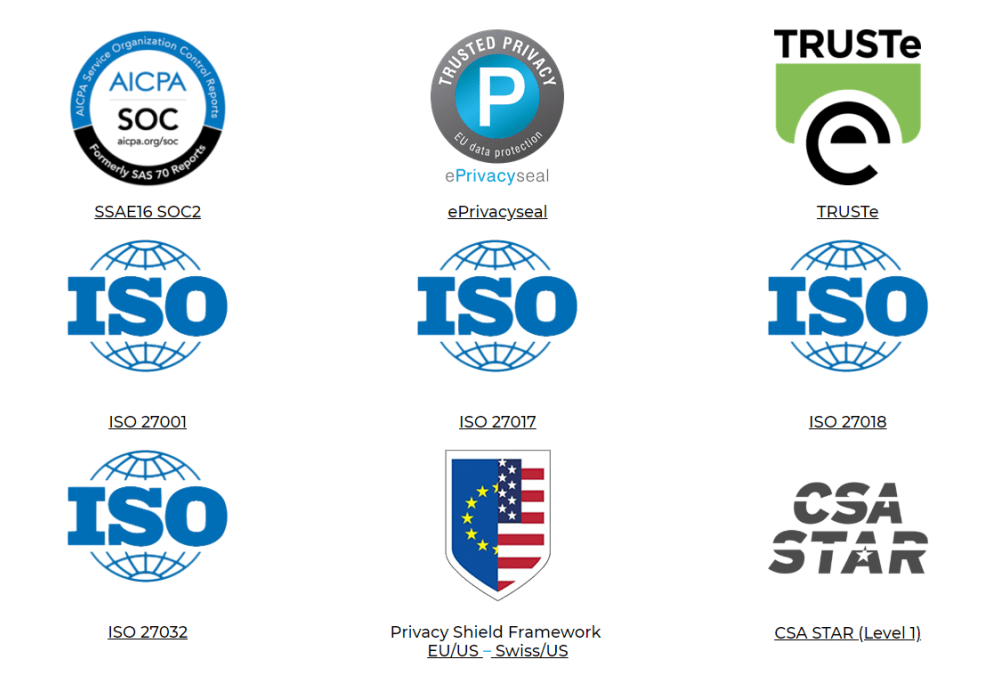
This mobile app attribution platform also isolates each customer’s account data from that of other customers. Additionally, it encrypts the data at rest. Also, AppsFlyer’s web servers use strong encryption protocols. These protocols secure the connections between its users’ devices and its own web services and servers.
Every change made at AppsFlyer is measured, reviewed, and approved by following a strict process. This process ensures that operational changes meet AppsFlyer’s business goals and compliance guidelines. These include GDPR, TRUSTe, and ePrivacyseal.
Branch and Data Integrity
Branch ensures strict compliance with GDPR to secure the data it holds. This data security directive gives specific guidelines, including the right to object to data processing. However, to submit a GDPR end user request, you’ll have to go through the Branch GDPR portal. Then you must specify the end user’s advertising identifier (for example, IDFA or GAID). Also, you must specify the date when you received their request.
Just keep in mind that even after Branch stops tracking end users, they’ll still be able to generate and share Branch links. In addition, basic deep-linking functionality will also continue to work.
However, end users who object to data processing won’t be able to benefit from seamless customer journeys across multiple platforms. (Branch enables marketers to offer their other end users these seamless journeys.)
Which Mobile App Attribution Platform Is Right for You?
With the right mobile app attribution platform, you’ll be able to find out how a user first learns about your app, what drives them to install it, and how they interact with it. This information can help you optimize your marketing campaigns and convert more customers.
After reading this article, between AppsFlyer and Branch, which mobile app attribution platform are you leaning toward and why?


